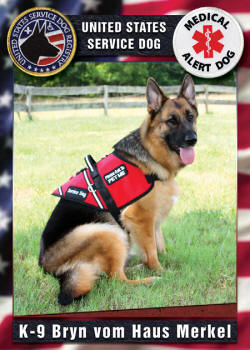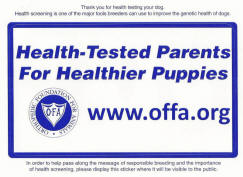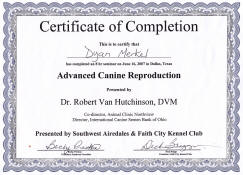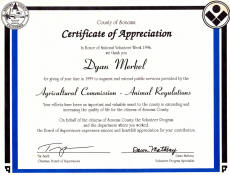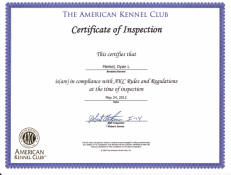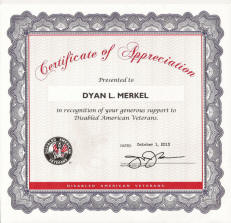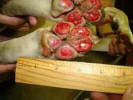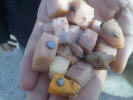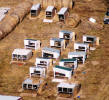|
the working GERMAN SHEPHERD
|
THE WORLDS PREMIER
WORKING DOG
by Elizabeth Stidham
Not only is
the German Shepherd Dog one of the world's most popular breeds, but it
also is the breed of choice of most working dog handlers and of service
organizations that use dogs. A German Shepherd Dog possessing the
physical and psychological attributes called for in the breed standard is
an incomparable canine assistant capable of performing many functions and
filling many roles. No breed has served humanity in more ways than
the German Shepherd Dog.
From its coat
to its courage, whether guide dog or guard dog, the traits bred into the
German Shepherd Dog are those required by the world's premier working dog.
Created over a century ago to be a superior utility dog with tremendous
character, the breed is successfully fulfilling its mission.
The German
Shepherd Dog is of medium size, with great power and agility, strength adn
stamina. With proficient crawling, climbing and jumping ability, few
places are inacessible to the military, police, or search-and-rescue dog;
while its medium size allows the dog to be easily boodted throughsmall,
high openings or held inthe lap of its handler when being transported on a
small plane or helicopter.
The breed's
low-maintenace double coat probides complete protection in all cllimates
and is impervious to stickers and thorns. Dogs working in heavy
undergrowth or debris are quickly relieved of any burrs and dirt that may
cling to the coat by simple going-over with a comb. The weatherproof
qualities of the coat enable the dog to swim and work in inclement weather
and still remain comfortable.
The German
Shepherd Dog's hearty constitution and adaptability contribute directly to
its role as the world's premier working dog. Easiliy acclimating to
changes in weather, altitude, water and food without loss of health
or attitude allow the dogs to be shipped worldwide, at a moments notice,
to wherever their help is required.
Combining the
traits of superior interlligence and trainability with a great desire to
please produces a dog easily trained for a variety of jobs. The
addition of a strong aptitude for problem solving and a willingness to
work independently of the handler, if nescessary, give the German Shepherd
Dog the tools needed to make the responsible choices required of a true
working dog.
The loyalty of
the German Shepherd Dog is legendary; the depth of its bond to its handler
is well documented. This undying devotion gives the handler a canine
helper willing to learn all the handler can teach and perform all it has
learned. The bravery and proprietary attitude of the German Shepherd
Dog make it an excellent choice as a guardian.
Coupling
courage with calm confidence, independence with compliance, derring-do
with dignity, provides the balance that makes the German Shepherd Dog the
world's Premier working dog. Whatever the need - herder or house
dog, K-9 or companion, partner or pet - the German Shepherd Dog is well
equipped to fill any role.
|
ABLE
ASSISTANTS
by Liz Palika
German Shepherds excel as assistance, service therapy and guide dogs.
Loyal, intelligent
service to humanity is in German Shepherd Dog's blood. Max von
Stephanitz, the founder wanted a dog that would be noted for its
supreme intelligence, nobility and usefulness. He wanted a dog with a
sound mind in a sound body. And he got it.
Elizabeth Stidham, a German Shepherd breeder, said, "The loyalty of
the German Shepherd is legendary; the depth of its bond to its owner
is well-documented. Coupling courage with calm confidence,
independence with compliance, derring-do with dignity, provides the
balance that makes the German Shepherd the world's premier working
dog."
Since the early 1900s, German Shepherds have distinguished themselves
in many arenas, most notably in military, law enforcement and
search-and-rescue units. However, German Shepherd Dogs serve mankind
in many other ways, often quietly and unobtrusively.
HELPING PEOPLE
German Shepherds need a job, and if a job isn't available, they'll
find something to do. This desire to work, with their flexibility and
intelligence, has made the German Shepherd an awesome service dog.
The term service dog has come to mean dogs that assist people in some
fashion; not service as in military service. Service dogs may include
dogs that lead and assist the blind, dogs that alert the hearing
disabled to noises and alarms, dogs that pull wheelchairs and pick up
dropped items, and dogs trained for a thousand and one other useful
tasks.
Guide dogs are the oldest known assistance dogs. A fresco, dating from
79 AD, uncovered in the ruins of Pompeii, shows a blind man with a
staff being led across a marketplace by his dog.
The first Guide Dog in the United States was originally trained in
Switzerland, then it was placed with Morris Frank in the United
States. In 1927, an article in the Saturday Evening Post had
introduced the idea of guide dogs for blind World War I veterans.
Frank, a blind teenager in America, inquired about a dog for himself
and was paired with Buddy, a German Shepherd Dog. This man-and-dog
team paved the way for all future service dogs. In fact, Frank, in
return for Buddy's services, spent the rest of his life campaigning
for guide and service dogs and better medical care for dogs.
In the years since Buddy had introduced to America the concept of a
service or assistance dog, service dogs have enabled people who might
otherwise need help from other people to lead more independent lives.
Nowadays, many organizations select, acquire, train and place service
dogs. Some rely on volunteer puppy raisers, who socialize, raise and
begin basic training; others have teams of specialized trainers. In
addition, these groups must train and prepare the disable who will
care for the dogs for the rest of their lives. The dog-and-owner teams
must attend orientation and follow-up classes, learn how to continue
and reinforce the dog's training and feed, groom and care for their
new companions. Finally, these organizations educate the public about
the importance of service dogs and how to interact with these working
dogs.
HEARING DOGS
Max, a large black-and-red German Shepherd Dog, was a trained hearing
assistance dog. He was paired with Kathy, a teenager in San Diego.
(Kathy's last name has not been given at her family's request to
protect her privacy). Originally in special classes for the deaf,
Kathy had been pulled from those classes for individual tutoring,
primarily because she was having trouble with American Sign Language
and didn't like to lip read. Her parents were afraid that Kathy's
overprotective older brothers had babied Kathy so much that she wasn't
willing to try to complete her sometimes-difficult classes.
Kathy's father hoped that a hearing assistance dog would give Kathy
the motivation to learn and the confidence to attend a mainstream high
school. Kathy and Max attended special classes to learn what to expect
from each other. Upon graduation, Kathy was told that Max was her
responsibility, and only her responsibility. Her brothers were not to
help care for Max in any way.
The road to responsibility was hard; Kathy and Max both made mistakes.
However, within a year, Kathy and Max were attending a mainstream high
school. Kathy had become fluent in ASL and her lip reading had
improved.
Just to top everything off, Max cornered a burglar trying to enter a
downstairs bathroom window one night. Kathy's dad says, "I could not
have guessed how much this dog would affect our family. He has done so
much for us in such a short time. He will be a treasured part of our
family forever."
AWESOME THERAPY DOGS
Therapy dogs are dogs of any breed (or mixtures of breeds) who visit
people in hospitals, nursing homes, residential care facilities and
childcare centers to bring love, warmth and affection to those who
need it most. A dog can cuddle up to a lonely child, do tricks for a
depressed adult or give a senior kisses on the cheek.
Although the GSD breed standard (the written description of the breed)
states that the dog is to be self-confident with a certain aloofness
that does not lend itself to immediate and indiscriminate friendships,
the GSD can and has served admirably as a therapy dog. The GSD is
smart enough to figure out what is required during therapy dog visits,
and can put aside the aloofness that might otherwise interfere with
its work.
Just what goes into becoming a therapy dog? To be certified as a
therapy dog, the dogs must satisfy the following:
- The dog must be well
socialized to people of all sizes, shapes, ages and ethnic
backgrounds.
- The dog must like
people.
- The dog must have
had some obedience training and be able to sit, lay down and stay
for at least two minutes.
- The dog must be able
to walk on a leash nicely with other people around.
- The dog must be
under control and safe around other animals that might be
encountered during a visit, such as other dogs, a residential cat or
a patient's bird.
- The dog cannot jump
on or paw people.
- The dog should never
touch its mouth to people; either as a bite or as mouthing (grabbing
a hand, for example.) Licks or kisses can be given on command.
- The dog should not
react fearfully to sounds it might encounter during a visit, such as
metal bowls falling to the floor, a wheelchair's squeaks and rattles
or the hissing of an air hose or an intercom.
- The dog should not
react fearfully to visual stimuli that it might encounter during a
visit, such as a sheet snapping over a bed or a person walking
hunched over a walker.
- The dog's owner must
also enjoy people and be willing to do what is necessary to present
the dog to people so that the dog can work its magic.
MATCHING DOGS
& PEOPLE
Although a German Shepherd was the first guide dog in America and the
breed has been used almost exclusively for many years, today, most
schools that train assistance dogs use several breeds. These
organizations attempt to match the dog's personality and traits with
the person's needs and abilities. Labrador Retrievers, Golden
Retrievers, Doberman Pinschers and Australian Shepherds are commonly
used, and even Standard Poodles have been used by some schools. For
many, however, the German Shepherd is still the breed of choice.
The reasons for using each breed varies. Sometimes it has been difficult
for schools to find German Shepherds that were temperamentally and
physically sound. Other times, the trainers needed skills and traits
that other breeds could better offer. The German Shepherd, with all
its wonderful qualities, is not for everyone. It does have some traits
that make it a less than desirable companion for some people.
Although every dog of every breed is unique, some generalizations can
be made. Most guide and assistance dog trainers agree that German
Shepherds and Standard Poodles work faster than Labs and Goldens. They
walk faster, and turn and react more quickly. These dogs must be
paired with people who can work at this speed, such as those who are
healthy and active.
People who walk more slowly or have slower reactions are probably
better off with a slower, softer dog.
Because of the breed's strong drive to work, it must have a
challenging job. A sedentary owner will not do well with a German
Shepherd assistance dog; the shepherd would probably get into trouble
while trying to find things to do.
The owner of a shepherd must be able to work with an intelligent dog
and teach it with a firm, yet gentle, hand. These dogs cannot and will
not tolerate abusive handling.
The German Shepherd is also a high-energy dog that needs daily
exercise. If the dog's owner is a busy go-getter, that's great.
However, if the owner is not, the dog will need daily strenuous
exercise.
Living with a German Shepherd requires a few compromises and
understanding that the breed sheds is one of them. A good vacuum
cleaner is another. People who dislike dog hair in the house should
not have a German Shepherd. The owner should be able to groom and
brush the dog regularly to care for its weather-resistant, double
coat.
Trainers use guidelines such as these to select dogs to be admitted
into training and when pairing up trained dogs with their future
partners. Ultimately, the decision whether to use a dog is based upon
the dog's physical and emotional soundness, its working drive and its
responsibilities to its handler.
CONSTANT COMPANION
A guide dog, assistance or other service dog serves its owner much
more than by simply doing the job for which it was trained. A service
dog does its job, yes, but it is also very much a companion. A
disability can be frightening and may cause a person to feel like a
social outcast or to feel different. A dog, though, is a friend and
companion that doesn't care about disabilities.
The dog also facilitates social contacts. Many people speak to a
disabled person with a dog when they might not speak to a disabled
person who is alone. A dog allows a disabled person to pursue a
career, education and leisure activities that might not have been
possible had the person needed to rely on others for assistance.
Tom Naden of Vista, California, and his guide dog Vargas give
presentations to interested groups about the benefits of guide dogs
and how they assuage loneliness. "I know what a lonely life it is with
just a stick [the white cane]," says Naden. "You can't talk to your
cane. Vargas is just like another person."
Virginia, a polio victim who is also severely arthritic, has nothing
but praise for her service dog, Bonnie. "I don't know when I've been
so happy. She has made my life so different. She has given me back my
will to live and now I'm never alone." She adds, "It's so nice to be
independent again."
Liz Palika is a Southern California
dog trainer and an award-winning freelance writer. Liz and her dogs
participate in a number of activities, such as obedience, carting,
agility, Frisbee, flyball and therapy dog work. Recent books she has
authored include All Dogs Need Some Training and Save That Dog!
(Howell Book House). |
|
This site
designed and maintained by Dyan Merkel of
DLM DESIGN STUDIO
|

